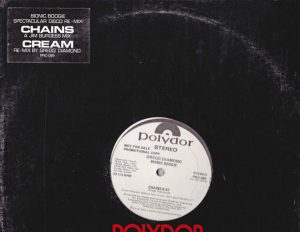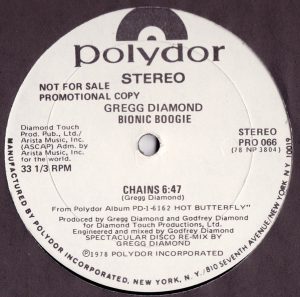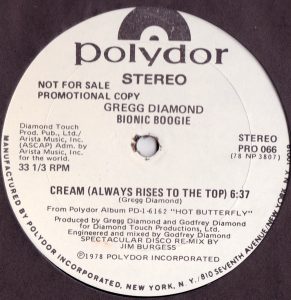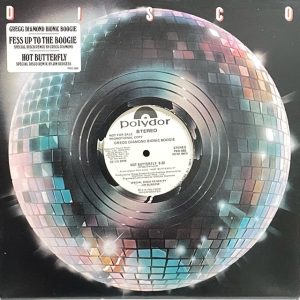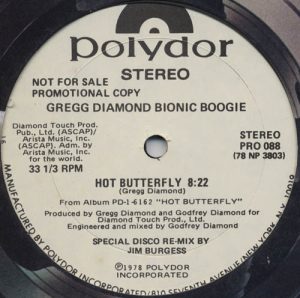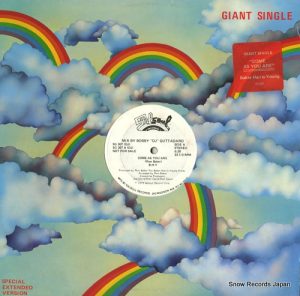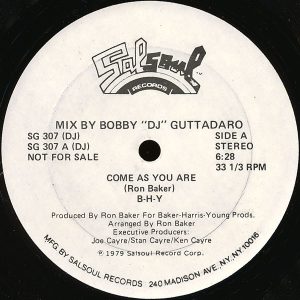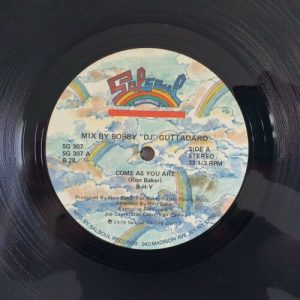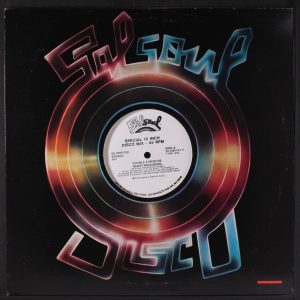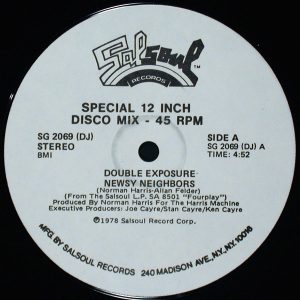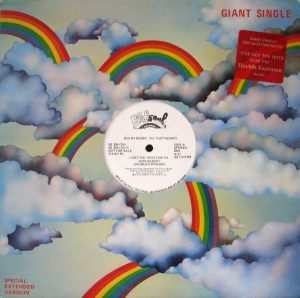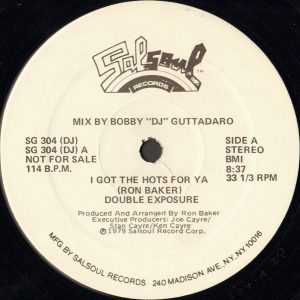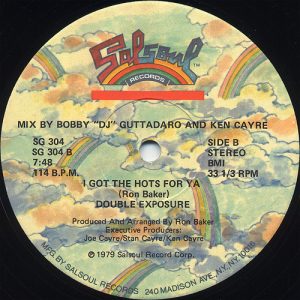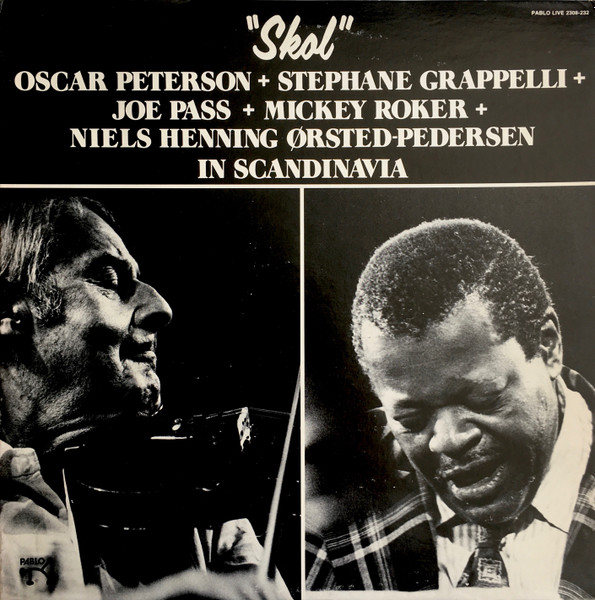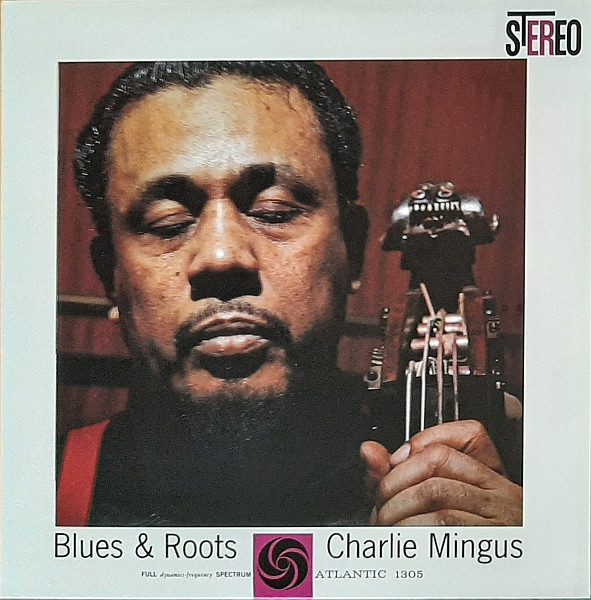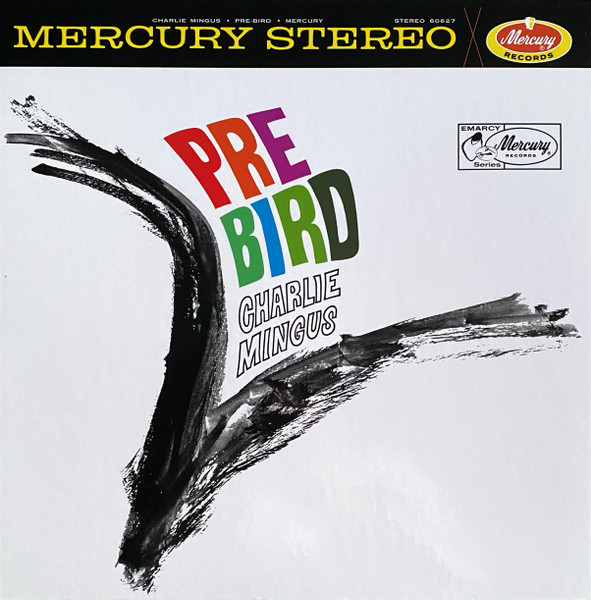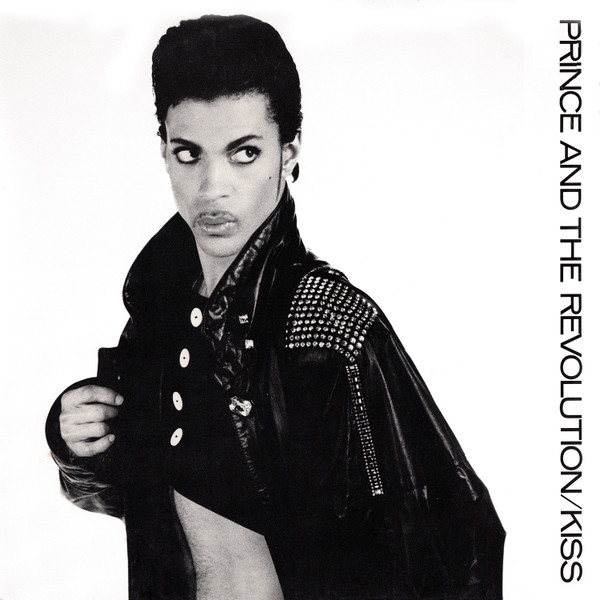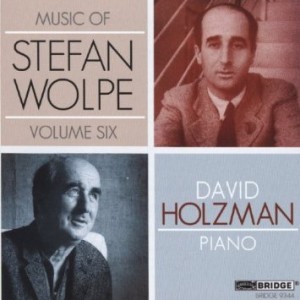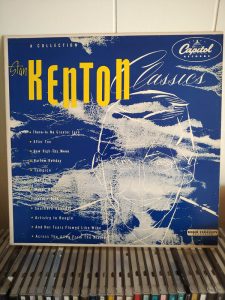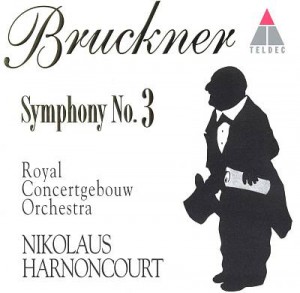This is an ongoing project by Claude Lemaire of Soundevaluations
206. Bionic Boogie, "Chains"/"Cream (Always Rises to the Top)." Polydor – PRO 066 (1978), 12" 33 1/3 rpm, promo. Genre: disco.
Bionic Boogie was the brainchild of American disco producer, musician, and songwriter Gregg Diamond, who rose to prominence in early 1976 with "More, More, More" (Buddah Records DISCO 102). Sung by ex-porn actress Andrea True Connection, and backed by Diamond's original piano riffs, the track became a major hit single during that spring. After contributing to her first two albums, towards the end of 1977, he released Bionic's debut LP featuring the hits "Dance Little Dreamer" and "Risky Changes" (Polydor PRO 036). This was followed a year later with a second album, Hot Butterfly, featuring three hit singles—the title track, "Chains," and "Cream (Always Rises to the Top)." The white label 12-inch promo submitted here has the "spectacular disco re-mix by Gregg Diamond" version of "Chains," while side B holds the LP version of "Cream"—and not the "spectacular disco re-mix by Jim Burgess" version as printed on the label. Engineered and mixed by brother Godfrey Diamond, with lacquer cut at Sterling Sound in New York, the sound is powerful, punchy, and muscled. Side A's "Chains"—which the chorus borrows from Moment of Truth's "Chained to your Love" (Salsoul Records SZS 5509)—is nevertheless quite original. The short intro consists of panned drum tom strikes in accelerando, then what appears to be a heavily distorted fuzzy electric guitar takes command, creating one of the hardest driving disco tracks of all time. The riff's relentless energy leaves the impression that the 116 bpm track clocks in at a much faster pace. The mix of male and female vocals at different intervals makes it interesting as well. Lastly the break breaks with tradition, providing panned percussive details and spacey sound effects, prancing over clear rhythm guitar augmented by brief brass contrasts. Incredibly "Cream" rises to the same level in quality, both musically and sonically. The 123 bpm track pummels the four on the floor in a more metronomic uncluttered presentation. Again, male and female vocals combine in a perfect blend. Mixing, mastering EQ choices, and disc-cutting are up there with the top! Must have disco and demo track from this white-label promo.
207. Gregg Diamond, Bionic Boogie, "Hot Butterfly"/"Fess Up to the Boogie." Polydor – PRO 088 (promo) or PD D 509, 2141 112 (1978), 12" 33 1/3 rpm. Genre: smooth soulful disco.
"Hot Butterfly" is the third track extracted from Diamond's second album as discussed just above. It is a much slower, smooth, soulful disco song around 93 bpm featuring his signature piano playing and riff and the rich vocals of Luther Vandross. These and the song's arrangements give it a very uplifting vibe. This is the "special disco re-mix by Jim Burgess." The staccato intro is kind of a slowed down take on The Trammps' "Disco Inferno" intro but spun in reverse, i.e. here, the notes are ramping up the staircase instead of ramping down before the main riff shuffles or drags along. The cute chorus has the vocals singing the title's lyrics in French—"Chanson Papillon"—while the song's bridge borrows from the bridge of Marvin Gaye's "What's Going On" (MFSL UD1S 2-008), as well as the intro to its following track "What's Happening Brother." This transforms into the breakdown, where instrument layers are peeled away in successive music measures as the song progresses, and towards the coda, congas now dominate the landscape on this higher plane. I have the regular red label pressing but I imagine the white label promo must be as good if not even better than my copy. Godfrey Diamond's mixing is once more divine, and the mastering's tonal balance is nearly on par with the previous selection with great kick attack, groovy piano sounds, plus a delicate harp appearing at certain intervals. Big soundstage in all three dimensions. Side B's "special disco re-mix by Gregg Diamond" of "Fess Up to the Boogie" did not reach the same success on the charts or in clubs, but is plenty enjoyable just the same, and its sound is impressive also with a very sharp kick, and highly panned trebly electric guitars. The minor blemish are the upper mids and lower treble of the piano coming off slightly hot in the mix within the detailed tonal balance.
208. B-H-Y, "Come as You Are"/"Opus BHY." Salsoul Records – SG 307 (1979), 12" 33 1/3 rpm. Genre: disco, Philly soul.
B-H-Y stands for Baker-Harris-Young, as in bassist Ron Baker, guitarist Norman Harris, and drummer Earl Young, the inseparable Philly-based trio behind such groups as The Trammps, M.F.S.B., Double Exposure, and the major backbone for The Philadelphia Sound. Mixing disco, Philly soul, and funky big band brass, this twelve-inch single did not turn out to be a big hit but it is still musically excellent, and sonically stunning. Both songs are exciting and upbeat, and it begs the question: how come they did not receive proper airplay on radio and in clubs? Recording engineers Carl Paruolo, Dick Devlin, and Jeff Stewart at Sigma Sound Studios in Philadelphia, mixing engineer Bob Blank at Blank Tape Studios in New York, and mastering-cutting engineer Jose Rodriguez at Sterling Sound in New York outdid themselves. This particular version was mixed by Bobby "DJ" Guttadaro. Exceedingly punchy in the kick drum and bouncy in the bass, the attack is sharply defined and to die for! Huge soundstage as a bonus. I have the regular Salsoul pressing but it also came out as a white label DJ promo.
209. Double Exposure, "Newsy Neighbors." Salsoul Records – SG 2069 (DJ) (1978), 12" 45 rpm, promo. Genre: Philly soul, soulful disco.
This Philadelphia-based singing quartet first formed in 1961 going under the name of the United Image, which spawned two lesser known singles—"Love's Creeping Up on Me" (Volt VOA-4065) in 1971 and "The African Bump" (Branding Iron Records BI-1834) in 1974. They hit their stride when they switched to Salsoul Records and had their first major hit in May 1976 with "Ten Per Cent" (Salsoul 12D-2008), the very first commercial 12-inch single available to the public—prior to this release, only deejays and radio stations had access to a few rare low-numbered promo copies. Although that song is a very important and exciting "classic" disco track, its sound quality doesn't quite meet my criteria for this TOP 500 LIST. Fortunately their fourth single released strictly as a 12-inch white label DJ promo does so in spades. Originally interpreted by Philly female trio First Choice from their 1973 debut album Armed and Extremely Dangerous (Philly Groove Records Incorporated PG 1400), "Newsy Neighbors" is given its male version counterpart. Co-written and produced by Norman Harris, engineers Carl Paruolo, Dirk Devlin, Ken Present, and Rocky Schnaars recorded it at Sigma Sound Studios and Alpha International Studios in Philadelphia, and Jose Rodriguez mastered and cut it at Sterling Sound in New York. Lasting just under five minutes, and cut at 45 rpm, it is not surprising that the sound is very dynamic, articulated, punchy, tonally balanced, breaths, and has a wide soundstage.
210. Double Exposure, "I Got the Hots For Ya" (mixed by Bobby "DJ" Guttadaro)/"I Got the Hots For Ya" (mixed by Bobby "DJ" Guttadaro, Ken Cayre). Salsoul Records – SG 304 (1979), 12" 33 1/3 rpm. Genre: disco, soulful disco, Philly soul.
This was their last disco hit released around June 1979. It boasts two different mixes of the same song done by Bobby "DJ" Guttadaro coasting at a mid-tempo of 114 bpm. Side A starts with hand claps and piano in the lead followed by the drums, then bass and brass come in, percussions, and vocals; while side B starts with the drum solo, followed by guitar, then bass and vocals. The latter version is more stripped down, putting the kick drum at the forefront with the bass line and vocals a close second. Produced, arranged, and written by Ron Baker, engineers Carl Paruolo, Dirk Devlin, Ken Present, and Rocky Schnaars recorded it at Sigma Sound Studios in Philadelphia, with mixing engineer Bob Blank at Blank Tape Studios in New York. Mastered and lacquer cut by Robert Ludwig at Sterling Sound in New York. I have the white label promo and the regular pressing, and both are very close but I have a very slight preference for my regular copy, the latter being a smidgen less sharp and warmer in the mids than the promo—but on another system it could go either way. Both mixes sound fantastic, with side A's mix sounding more detailed in the treble because of the tambourine and having more layers of instrumentation, while side B's mix predominates more in the bass and low mids, with outstanding heft, articulation, displacement, and solidity in the kick drum, precise electric bass lines, crisp and transparent electric guitar and vocals. The tonal balance especially on side B is so "on the spot" that you really feel like cranking it up a few notches. Another demo disco track with your woofer's x-max excursion being more the true volume limiting factor than one's own ears!
For more from Claude Lemaire go to his blog...
http://soundevaluations.blogspot.ca/




